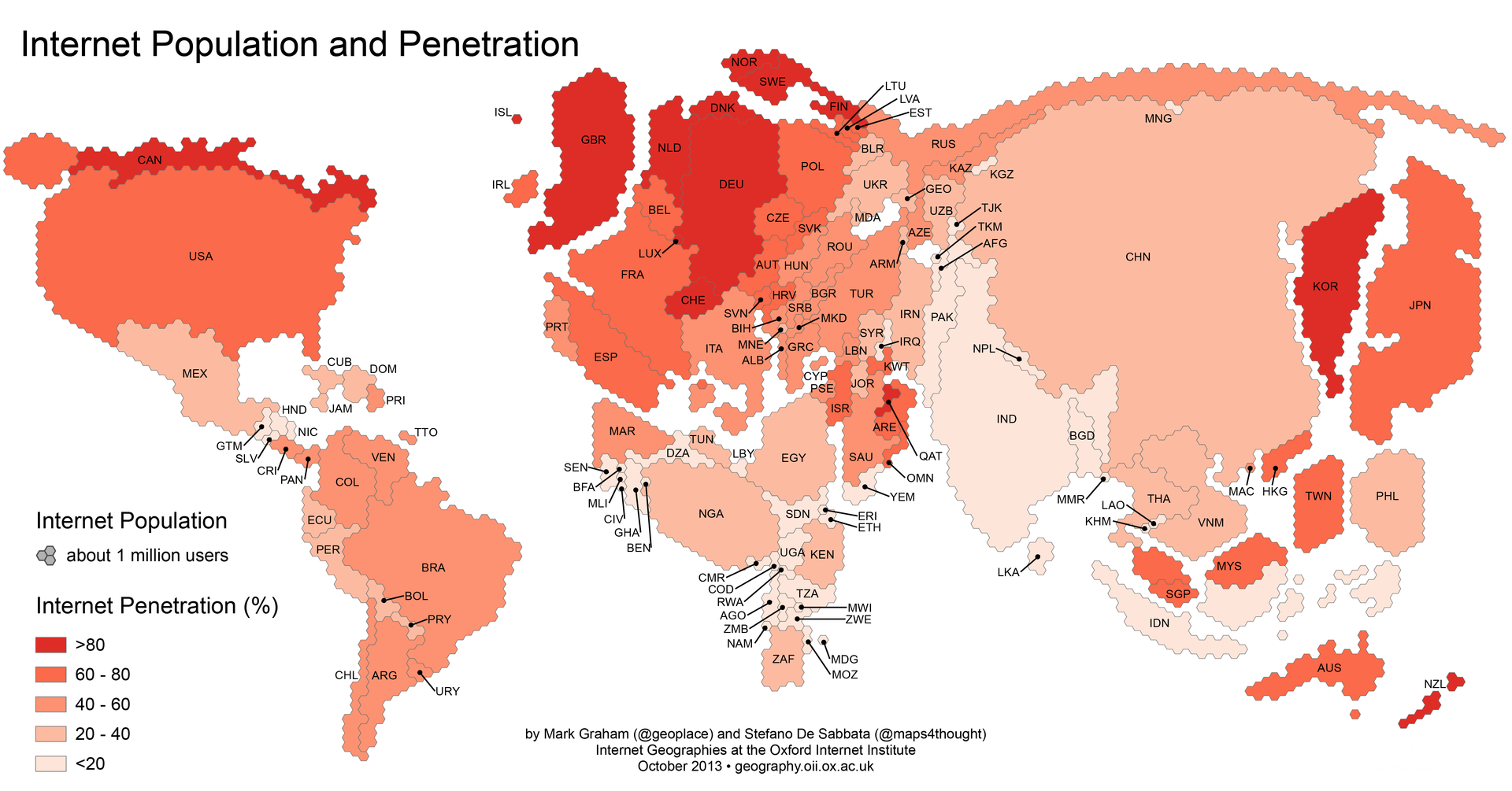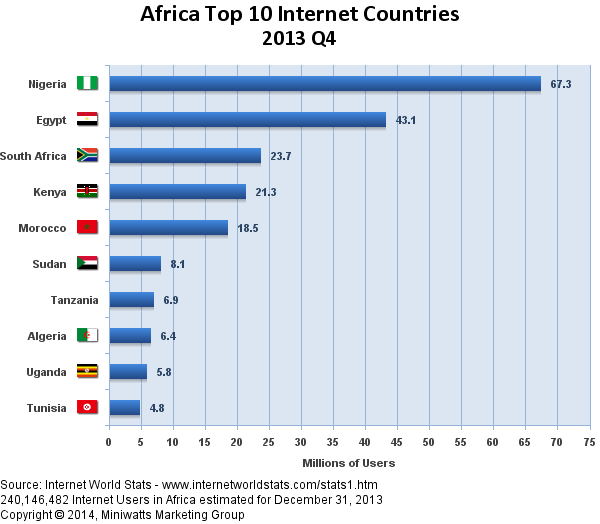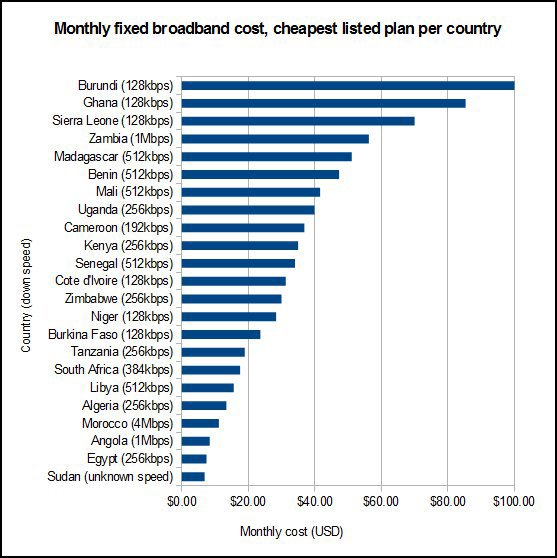The harsh everyday life of the Internet on the African continent
Every day in the world the need for increasing the capacity of telecommunication channels is growing. Requests for data center computing power are only increasing, ordinary consumers of IT services quickly become accustomed to high-quality Internet and simply require minimal network latency from providers even in the most remote parts of the Earth, which is already talking about densely populated areas.
The construction of new data centers has become an everyday event. The United States is currently the recognized leader in the total number of data centers, and China, like the whole Asian region, is steadily holding the first place in terms of computing power.
At this time of universal Internet welfare, there are still a number of countries in the world where there are no large data centers, the number and quality of Internet channels is very limited, and the price of network access for an ordinary user is exorbitant. The reasons for this state of affairs lie in both economic and political motives. Historically, most countries - Internet rogue located on the Black Continent, giving rise to a huge black spot on the map of the entire global IT infrastructure. How things are now with the Internet in Africa and what are the prospects for its development - this will be discussed further in the article.
')

Currently, according to available statistics, Africa, with a population of 1.1 billion, is a tiny part of the global Internet community. African users make up only about 9% of all users on the world wide web. This is due to the extremely low percentage of Internet access and its excessive cost in most of the African countries. Distribution of users in Africa is very uneven, which obviously makes the promotion of Internet infrastructure within the whole continent less efficient.
According to statistics for 2013, economically developed Nigeria became the leader in terms of the total number of Internet users (67,319,186 users). Next on the list: Egypt (43,065,211 users), South Africa (23,655,690 users), Kenya (21,273,738 users), Morocco (18,472,835 users), the rest of the countries have a minimum level of informatization of the society. All the countries listed are coastal and this has seriously contributed to their superiority over countries within the continent. After all, the underwater communication lines that have enveloped the coast of Africa play a crucial role for the region.

The scarcity of available Internet channels and the high cost of traffic for African people are the main deterrent barriers to the development of the IT sector. The small width of the channels, at the level of 10 Tbit / s, connecting the Black Continent with the world, trivially does not meet the needs of the population, which already arise, even despite the frankly low standard of living in the overwhelming number of countries. Price for 1 gigabyte of traffic across the continent can vary tenfold from $ 10 in developed coastal areas to $ 100 in the continent. The price level for a connected channel with unlimited traffic may also sometimes surprise the frankly corrupted cheap channels of residents of the northern latitudes of the planet.

Without capital investments in IT infrastructure, the situation obviously will not change, and since too high prices for Internet services in already poor countries simply do not leave chances for self-financing of the industry and make knowingly unprofitable investments from outside, the situation with informatization of a number of countries looks quite depressing.
The main feature of data centers in Africa is their attachment to the coasts. In the continental zone, there simply is not enough infrastructure that could support a more or less large data center.

The leader in the number of active data centers is South Africa. At the moment, there are 18 data centers, which is more than half of all data centers in Africa. The second country after South Africa in terms of data center was Egypt, located at the opposite end of the continent, sheltered 9 units. In countries such as Nigeria, Kenya and Morocco, there are 2 data centers each. The total number of data centers located in Africa is 33 units, and this is despite the fact that in some developed countries of the world sometimes there are much more impressive number of data centers. In Paris and its suburbs alone, there are 34. Given the number of Internet users already available with the existing infrastructure, the gulf that separates Africans from the rest of the global Internet community becomes apparent.
For perhaps the past 5 years, we have witnessed the rampant progress of technologies providing access and the Internet access itself. A significant role was played here by the technology of wireless high-speed Internet. Technical progress, though late, penetrates the Black Continent. Moreover, wireless Internet is something that can make a real revolution in Africa.

According to the latest studies, the volume of mobile Internet traffic in African countries in just one year, from May 2013 to May 2014, increased by 38%. With this result, Africa is ahead in growth even in such a dynamic region as Asia (although only in percentage terms), which makes this result even more impressive. This situation was a consequence of the fact that Internet users, with the recent advent of wireless technologies, were able to finally gain access to the network without huge investments by local infrastructure providers. As a result, the price of such access has become more sane than was the case with fixed Internet connections.
The African continent is still on the sidelines of civilization, new technologies are penetrating extremely slowly. Scattered around all corners of Africa, the hot spots of the modern world can become platforms for the inevitable development of a region, a region rich in both natural and human resources.
Despite the objectively difficult situation with the IT infrastructure, the emerging growth trend of mobile Internet users may, perhaps, be a turning point for most African countries. By planting as many Africans as possible on the Internet, companies will finally be able to get the much-needed funds to develop the continent’s still very limited networks. The only thing that exceeds the potential superprofits of companies that may become pioneers in the countries of the continent with a population of more than 1 billion, these are the risks with which they face.

The construction of new data centers has become an everyday event. The United States is currently the recognized leader in the total number of data centers, and China, like the whole Asian region, is steadily holding the first place in terms of computing power.
At this time of universal Internet welfare, there are still a number of countries in the world where there are no large data centers, the number and quality of Internet channels is very limited, and the price of network access for an ordinary user is exorbitant. The reasons for this state of affairs lie in both economic and political motives. Historically, most countries - Internet rogue located on the Black Continent, giving rise to a huge black spot on the map of the entire global IT infrastructure. How things are now with the Internet in Africa and what are the prospects for its development - this will be discussed further in the article.
')

Currently, according to available statistics, Africa, with a population of 1.1 billion, is a tiny part of the global Internet community. African users make up only about 9% of all users on the world wide web. This is due to the extremely low percentage of Internet access and its excessive cost in most of the African countries. Distribution of users in Africa is very uneven, which obviously makes the promotion of Internet infrastructure within the whole continent less efficient.
According to statistics for 2013, economically developed Nigeria became the leader in terms of the total number of Internet users (67,319,186 users). Next on the list: Egypt (43,065,211 users), South Africa (23,655,690 users), Kenya (21,273,738 users), Morocco (18,472,835 users), the rest of the countries have a minimum level of informatization of the society. All the countries listed are coastal and this has seriously contributed to their superiority over countries within the continent. After all, the underwater communication lines that have enveloped the coast of Africa play a crucial role for the region.

The rich get richer, the poor get poorer
The scarcity of available Internet channels and the high cost of traffic for African people are the main deterrent barriers to the development of the IT sector. The small width of the channels, at the level of 10 Tbit / s, connecting the Black Continent with the world, trivially does not meet the needs of the population, which already arise, even despite the frankly low standard of living in the overwhelming number of countries. Price for 1 gigabyte of traffic across the continent can vary tenfold from $ 10 in developed coastal areas to $ 100 in the continent. The price level for a connected channel with unlimited traffic may also sometimes surprise the frankly corrupted cheap channels of residents of the northern latitudes of the planet.

Without capital investments in IT infrastructure, the situation obviously will not change, and since too high prices for Internet services in already poor countries simply do not leave chances for self-financing of the industry and make knowingly unprofitable investments from outside, the situation with informatization of a number of countries looks quite depressing.
The specifics of African data centers
The main feature of data centers in Africa is their attachment to the coasts. In the continental zone, there simply is not enough infrastructure that could support a more or less large data center.

The leader in the number of active data centers is South Africa. At the moment, there are 18 data centers, which is more than half of all data centers in Africa. The second country after South Africa in terms of data center was Egypt, located at the opposite end of the continent, sheltered 9 units. In countries such as Nigeria, Kenya and Morocco, there are 2 data centers each. The total number of data centers located in Africa is 33 units, and this is despite the fact that in some developed countries of the world sometimes there are much more impressive number of data centers. In Paris and its suburbs alone, there are 34. Given the number of Internet users already available with the existing infrastructure, the gulf that separates Africans from the rest of the global Internet community becomes apparent.
Mobile revolution
For perhaps the past 5 years, we have witnessed the rampant progress of technologies providing access and the Internet access itself. A significant role was played here by the technology of wireless high-speed Internet. Technical progress, though late, penetrates the Black Continent. Moreover, wireless Internet is something that can make a real revolution in Africa.

According to the latest studies, the volume of mobile Internet traffic in African countries in just one year, from May 2013 to May 2014, increased by 38%. With this result, Africa is ahead in growth even in such a dynamic region as Asia (although only in percentage terms), which makes this result even more impressive. This situation was a consequence of the fact that Internet users, with the recent advent of wireless technologies, were able to finally gain access to the network without huge investments by local infrastructure providers. As a result, the price of such access has become more sane than was the case with fixed Internet connections.
African conquest
The African continent is still on the sidelines of civilization, new technologies are penetrating extremely slowly. Scattered around all corners of Africa, the hot spots of the modern world can become platforms for the inevitable development of a region, a region rich in both natural and human resources.
Despite the objectively difficult situation with the IT infrastructure, the emerging growth trend of mobile Internet users may, perhaps, be a turning point for most African countries. By planting as many Africans as possible on the Internet, companies will finally be able to get the much-needed funds to develop the continent’s still very limited networks. The only thing that exceeds the potential superprofits of companies that may become pioneers in the countries of the continent with a population of more than 1 billion, these are the risks with which they face.

Source: https://habr.com/ru/post/242681/
All Articles